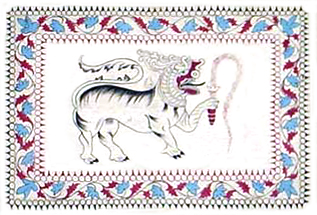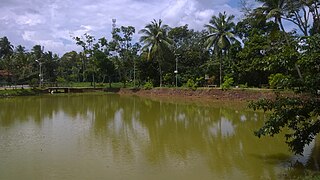Related Research Articles

Dominicus Corea also known as Domingos Corea and Edirille Rala, was the son of Don Jeronimo Corea and Anna Corea. Don Jeronimo Corea was also known as Mudaliyar Vikramasinha, Commander-in-Chief of King Mayadunne's army. Jeronimo Corea was assassinated by King Mayadunne's son, Rajasinghe. Dominicus Corea was born in Colombo in 1565. At that time, the Portuguese had colonised Ceylon, and his parents converted to Catholicism.

The Kingdom of Kandy was an independent monarchy of the island of Sri Lanka, located in the central and eastern portion of the island. It was founded in the late 15th century and endured until the early 19th century.

Rajasinghe I was a king of the Kingdom of Sitawaka. He is known for his extreme bravery and patriotism. Born as Tikiri Bandara to King Mayadunne of the Kingdom of Sitawaka, the name "Rajasinha" was given to him after a fierce battle against Portuguese forces. Rajasinha means the King of Lions.
Bhuvanekabahu VI of Kotte, known also as Sapumal Kumaraya and Chempaka Perumal, was by self admission an adopted son of Parakramabâhu VI whose principal achievement was the conquest of Jaffna Kingdom in the year 1447 or 1450. He ruled the kingdom for 17 years when he was apparently summoned to the south after the demise of his adopted father. According to a primary source Rajavaliya, he killed the grand son of Parakrama Bahu VI namely Vira Parakrama Bahu or Jaya Bahu but Do Couto, however, who was well-informed, says after a few years' reign the king died and his half-witted son was put on the throne by his aunt, who two years later finding herself unable to rule sent for Sapumal Kumaraya from Jaffna.

Vimaladharmasūriya I was a king of Kandy from 1590 to 1604. His reputation was built when he successfully repulsed two major Portuguese offensives on Kandy, the Campaign of Danture in 1594 and the Battle of Balana in 1602, in both of which the Portuguese were humiliatingly defeated.

The Kingdom of Sitawaka was a kingdom located in south-central Sri Lanka. It emerged from the division of the Kingdom of Kotte following the Spoiling of Vijayabahu in 1521. Over the course of the next seventy years it came to dominate much of the island. Sitawaka also offered fierce resistance to the Portuguese, who had arrived on the island in 1505. Despite its military successes, Sitawaka remained unstable, having to contend with repeated uprisings in its restive Kandyan territories, as well as a wide-ranging and often devastating conflict with the Portuguese. Sitawaka disintegrated soon after the death of its last king Rajasimha I in 1593.

Mayadunne (1501–1581) was a king of the Kingdom of Sitawaka, who ruled for 60 years between 1521 and 1581. Mayadunne was a fierce opponent of the Portuguese, who had arrived on the Island in 1505. He devoted his whole life attempting to oust his brother Bhuvanekabahu, the king of Kotte and thereby preserve the independence of Lanka, which was being undermined by the Portuguese intrigue. He constantly invaded the territory of Bhuvanekabahu of Kotte.
The Battle of Mulleriyawa in 1559 was a battle and a part of the Sinhalese–Portuguese War. It was one of the most decisive battles in Sri Lankan history and considered as the worst defeat of Portuguese during that period. According to local chronicles the marshlands of Mulleriyawa turned red with blood after the annihilation of the Portuguese. With this victory Sitawaka emerged as a military power which able to challenge the Portuguese expansion.
The Wijayaba Kollaya took place in the Kingdom of Kotte on the island of Ceylon in 1521. The three sons of King Vijayabahu VI mutinied against their father, killing him, and divided the Kingdom among themselves. The three sons were products of the king's first marriage and were named Bhuvanekabahu, Pararajasingha and Mayadunne. Queen Kiravella, whom the king married second, had a son named Deva Rajasinghe by her previous marriage. The princes discovered that the king intended to make Devaraja the heir to the throne, at the request of his second queen, and became hostile to the king, and hired a foreigner to murder the king in the palace.

The Kingdom of Kotte, centered on Sri Jayawardenepura Kotte, was a kingdom that flourished in Sri Lanka during the 15th century.
Raigama Bandara also known as Pararajasinghe was the son of Vijayabahu VII (1521) and brother of Mayadunne and Buvanekabahu VI. When Kingdom of Kotte was divided due to the incident known as "Wijayaba Kollaya", which resulted the assassination of king Vijayabahu, Pararajasinghe became the ruler of Raigama. Raigam Bandara is known as a good ruler who upheld the economy of the Raigama. However, after a battle with Kingdom of Kotte the family of Raigam Bandara had fled to Matara as a result of miscommunication. The fleeing of the family was followed by downfall of the ruler himself. The only straight descendants of the king still live bearing the name of "Mohotti" in Matara and in North Central province.
Bhuvanaikabahu VII was King of Kotte in the sixteenth century, who ruled from 1521 to 1551. He was the eldest son of Vijayabahu VII of Kotte, whom he succeeded, and his chief queen Anula Kahatuda. He was born in 1468 and his brothers were Mayadunne of Sitawaka and Rayigam Bandara. After his father married a second time, his new queen brought a son from another relationship called Deva Rajasinghe, who the king intended to pass on the crown to, and Bhuvanaikabahu and his two brothers responded by fleeing the kingdom, and on their return they had an army given by the King of Kandy.

The Edirimanne Corea Family Union (ECFU) is a group set up to 'foster interaction' among the members of the powerful Corea family in the island of Sri Lanka. The Corea family is one of the leading families of Sri Lanka. They trace their ancestry to Dominicus Corea also known as Edirille Rala who was crowned King of Kotte and Sitawaka in Sri Lanka - Dominicus Corea was born in Colombo in 1565.
The Siege of Kotte from November 1557 – November 1558 was a battle part of the Sinhalese–Portuguese War. A 50,000 strong Sitawaka army led by King Mayadunne besieged Sri Jayawardenapura Kotte, the capital of Kotte Kingdom for 12 months against a combined force of Portuguese and lascarins led by Captain-major Dom Afonso Pereira de Lacerda. After receiving reinforcements from Mannar, Portuguese made a sally and succeeded in forcing the besiegers to withdraw. This siege marked the beginning of a series of battles between Portuguese and Sitawaka forces, and ultimately ended as Portuguese abandoned Sri Jayawardenapura Kotte in 1565.
The Danture campaign comprised a series of encounters between the Portuguese and the Kingdom of Kandy in 1594, part of the Sinhalese–Portuguese War. It is considered a turning point in the indigenous resistance to Portuguese expansion. For the first time in Sri Lanka a Portuguese army was essentially annihilated, when they were on the verge of the total conquest of the island. A 20,000-strong Portuguese army, led by Governor Pedro Lopes de Sousa, invaded Kandy on 5 July 1594. After three months, severely depleted by guerilla warfare and mass desertions, what remained of the Portuguese army was annihilated at Danture by the Kandyans under King Vimaladharmasuriya. With this victory, the Kingdom of Kandy emerged as a major military power; it was to retain its independence, against Portuguese, Dutch, and British armies, until 1815.
Veediya Bandara was the commander-in-chief of the Kingdom of Kotte, Sri Lanka, during the reign of Bhuvanaikabahu VII of Kotte (1521–1551). He was a gifted warrior and widely regarded as one of the greatest generals of Sri Lankan history. Well known for his prowess of warfare, he was the central figure of the Kotte army, in a series of relentless wars against King Mayadunne of Sitawaka and occasionally, against the Portuguese. Being impetuous by nature, he got himself involved in many scandals, including the murder of his wife, Samudra Deviya, the daughter of his king.

Dewalapola is a small rural area in Minuwangoda Divisional Secretariate of Gampaha District, Western Province, Sri Lanka. It is situated on the 245/1 Nittambuwa - Katunayake / Airport bus route between Veyangoda and Minuwangoda.

Pathaha Pokuna is an ancient bathing tank or pool situated in Udugampola, Sri Lanka. It is located approximately 0.45 km (0.28 mi) from Udugampola Roundabout and close to the historic temple Uththararama Purana Vihara. The pond has been formally recognised by the Government as an archaeological protected monument in Sri Lanka. The designation was declared on 8 July 2005 under the government Gazette number 1401.

Uththararama Purana Vihara is a historic Buddhist temple situated at Udugampola in the Western province, Sri Lanka. The temple is located on Udugampola – Weediyawatta junction road approximately 0.5 km (0.31 mi) away from the Udugampola Roundabout. The temple has been formally recognised by the Government as an archaeological site in Sri Lanka. The designation was declared on 7 July 2005 under the government Gazette number 1401.
Sakalakala Wallabha, was the viceroy or provincial king of the sub kingdom of Udugampola in the Kotte Kingdom during the sixteenth century. He was the son of King Veera Parakramabahu VIII of Kotte and his chief queen's sister. His brother, Thaniya-Vallabha, was the viceroy of Katupiti Madampe. He had four step brothers, Dharma Parakramabahu, Vijayaratne, Rajasingha and Raigam Bandara. The Rajaveliya recounts how together with his brother, he defeated a Muslim rebel, who terrorised the area named 'Kadirayana' and restored peace.
References
- ↑ P.E Pieris, p. 43; Rajavaliya
- ↑ Rajavaliya, p. 75
- ↑ Rajavaliya, p. 76
- ↑ Rajavaliya, p. 76; P.E Pieris, p. 44
- ↑ Rajavaliya, p.76; P.E. Pieris Ceylon and the Portuguese, 1505-1658, p. 45
- ↑ Rajavaliya p. 76; L.E Blaze History of Ceylon: Revised and Enlarged, p. 130
- ↑ Queyroz Temporal and Spiritual Conquest of Ceylon, p. 204; Arnold Wright 20th Century Impressions of Ceylon, p.46
- ↑ Arnold Wright, p. 46; Queyroz, p. 204; Rajavaliya, p. 77